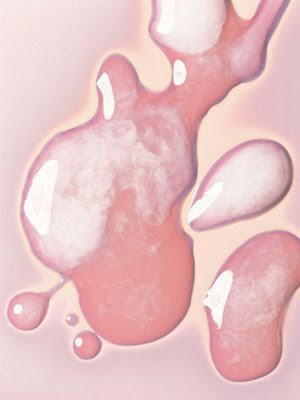.jpg) [image by Matthias Herrmann]
[image by Matthias Herrmann] Sabin Russell, Chronicle Medical Writer
Published 12/14/07
German AIDS researchers have discovered a protein common in semen that boosts the infectious potential of HIV 100,000-fold - a remarkable finding that may show how the virus can spread through sexual contact and also suggests new strategies to stop the epidemic.
If scientists can find a drug or chemical that blocks these infection-promoting proteins, it would go a long way toward development of a microbicide, a vaginal cream or gel that could protect sex partners against AIDS.
What is catching scientists' attention is the 100,000-fold increase. "I was so surprised that I did not believe the numbers," said Dr. Frank Kirchhoff, leader of the University of Ulm laboratory that found the protein. "But we did the experiment multiple times, and the results were always the same."
The discovery was made possible by advanced techniques in laboratory screening for tiny proteins. There are more than 900 different kinds in human semen, and these proteins in turn break down into smaller molecular chains that also may carry out important biological tasks.
In this case, researchers at the University of Ulm were screening hundreds of different molecules from semen samples in the hope of finding some that naturally blocked HIV, the virus that causes AIDS.
Instead, they stumbled upon protein fragments that do the opposite. The fragments dramatically boost HIV infection by clustering into microscopic rafts that ferry crowds of virus particles to cell surfaces, like landing craft disgorging invaders on a beach.
Their findings were released today in advance of Friday's publication of the journal Cell.
Although HIV has been understood to be a sexually transmitted disease for a quarter century, relatively little work has been done in analyzing what role semen may play in its transmission. And, it seems, few scientists have spent much time analyzing what Kirchhoff calls "pools" of donated semen. "People haven't dissected the individual components of semen," he said.
The latest work is the product of an emerging field in biotechnology called proteomics, the study of the molecular structure and function of proteins.
The new study suggests that scientists may have been missing something very important. "This is one of the most interesting new perspectives on HIV transmission to emerge in years," said Dr. Warner Greene, director of the Gladstone Institute of Virology and Immunology in San Francisco.
Greene said the work may solve a mystery that has puzzled AIDS researchers - why a virus that appears weakly infectious in laboratory dishes can spread explosively through sexual contact.
When researchers try to infect human cells under a microscope with HIV, it takes between 1,000 and 100,000 particles of the virus to cause a successful infection. That's weak, as viral infectivity goes. But when the proteins found by Kirchhoff are added to the mix, it is possible to start a successful infection with as few as three particles of virus.
If such a weak virus can be turned into a monster by a molecule present in semen, it raises the possibility that knocking that molecule out - or even hobbling it - could make HIV suddenly much more difficult to spread.
Greene is so enthusiastic about this discovery that he has started a project to find ways of blocking the protein. But he concedes that this search will not be quick or easy.
Dr. Tony Fauci, director of the National Institute for Allergy and Infectious Diseases, said the science behind the German study is impressive, but the laboratory dish findings are a long way from producing a practical solution for people. "It is a surprising finding, but I would be cautious about how important this is going to be," he said.
Fauci also noted that sexual transmission is only one route of HIV infection. Women can pass the virus to their newborns with breast milk, where presumably no similar HIV-promoting proteins exist. It is also clear that other factors, such as genital ulcers caused by diseases including herpes and syphilis, have a well-documented role in enhancing transmission of the virus.
Read the rest in the San Francisco Chronicle.





No comments:
Post a Comment